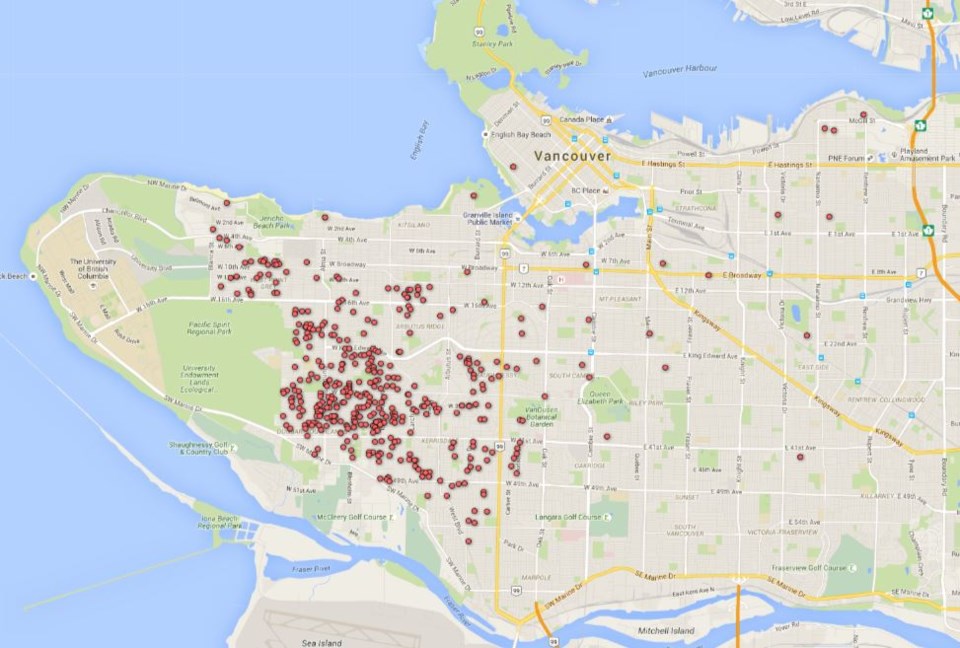Caroline Adderson hopes the visual impact of an interactive map depicting a fraction of the heritage houses torn down in recent years will bolster the effort to save the city’s character homes.
Adderson runs the popular Facebook page Vancouver Vanishes, which now has more than 11,000 likes. She posts photos of homes that are being torn down to draw attention to heritage concerns.
Andrea Leung, a recent follower of the page that launched in January 2013, offered to map out the demolitions Adderson has been tracking. The result shows locations, images and historical information of 410 demolished homes, mostly on Vancouver’s West Side where Adderson lives.
Adderson notes the map only represents only a small sample of actual demolitions, pointing out 927 demolition permits were issued in 2013, 993 in 2014 and 1,106 in 2015. As of the end of June 2016, 506 had been issued.
“I was astonished to think I had found 410 houses and that’s just one person,” she told the Courier. “If everybody was doing this, the whole city would look like it had a bad case of the measles.”
Leung said she started reading Adderson's Facebook page a few months ago and wanted to get a better sense of the information being provided. She thought a map would be much easier to relate to.
"When I first started doing this, I was doing it out of curiosity, trying to make sense of what was going on on the Facebook page because it sounded so urgent and alarming," she said. "And because the information comes bit by bit every other day, it's very hard to get a bigger picture sense of what [is going on]."
Leung said the fact the data set isn't complete is a shortcoming of the map — she points to houses that have been knocked down in the Cambie Corridor and Granville Street areas that aren't noted on the map — but she still hopes it gives viewers a better understanding of what's being posted on the Vancouver Vanishes page.
"At least it gives me some idea of what changes have taken place because I don't usually walk the streets in the area like Caroline," she said.
Adderson posts three times a week, but has a backlog of photos she hasn’t used yet. She doesn’t want to depress people or drive them away from her page by posting more often.
She considers the Vancouver Vanishes page an informal petition designed to show politicians the destruction of heritage that’s been happening in the city, and the fact that people care it’s happening. (Volunteers sometimes submit photos of homes that were knocked down in their neighbourhoods, which Adderson also posts on the page.)
“Quite often I have people in the comment box saying that this is the most depressing page on Facebook and people saying, 'I can’t take it anymore,'” she said. “I always have to say, ‘Please don’t give up — I want you to vote against this.’”
The map, Adderson said, will give people an idea what it looks like to have so many heritage homes knocked down.
“This is a time when you cannot have a conversation that’s not about affordability and every dot in my area represents a loss of density and a loss of affordability,” she said. “What I’m trying to get city council to realize is there’s potential in these homes to solve so many problems.”
Adderson said while some argue newer homes are more energy efficient, she maintains that calculation should include the embodied energy used in the transportation and fossils fuels used in the destruction of the original houses.
Larger homes might have 11-foot ceilings and seven bathrooms and a short life expectancy, she added.
“These [heritage houses] are smaller buildings on large lots, so they have this great potential for infill and [the city] could have tax breaks and encourage people to put in laneway [homes] and have suites in their houses,” she said. “[And] if you downzone so you can’t build a much larger home, then these properties aren’t bulldozer bait anymore.”
Adderson recalls buying her own home in 1999 when “character home” was a selling feature, while now such homes are crushed.
“This is how a city, house by house, is transformed into a place that is not green and not dense and not affordable,” she said.
@naoibh



